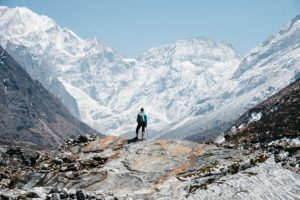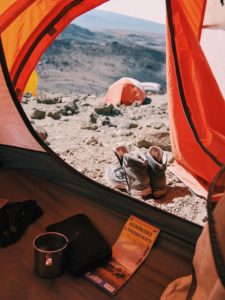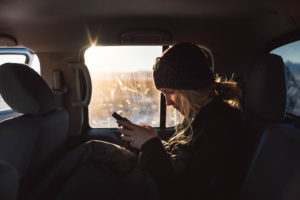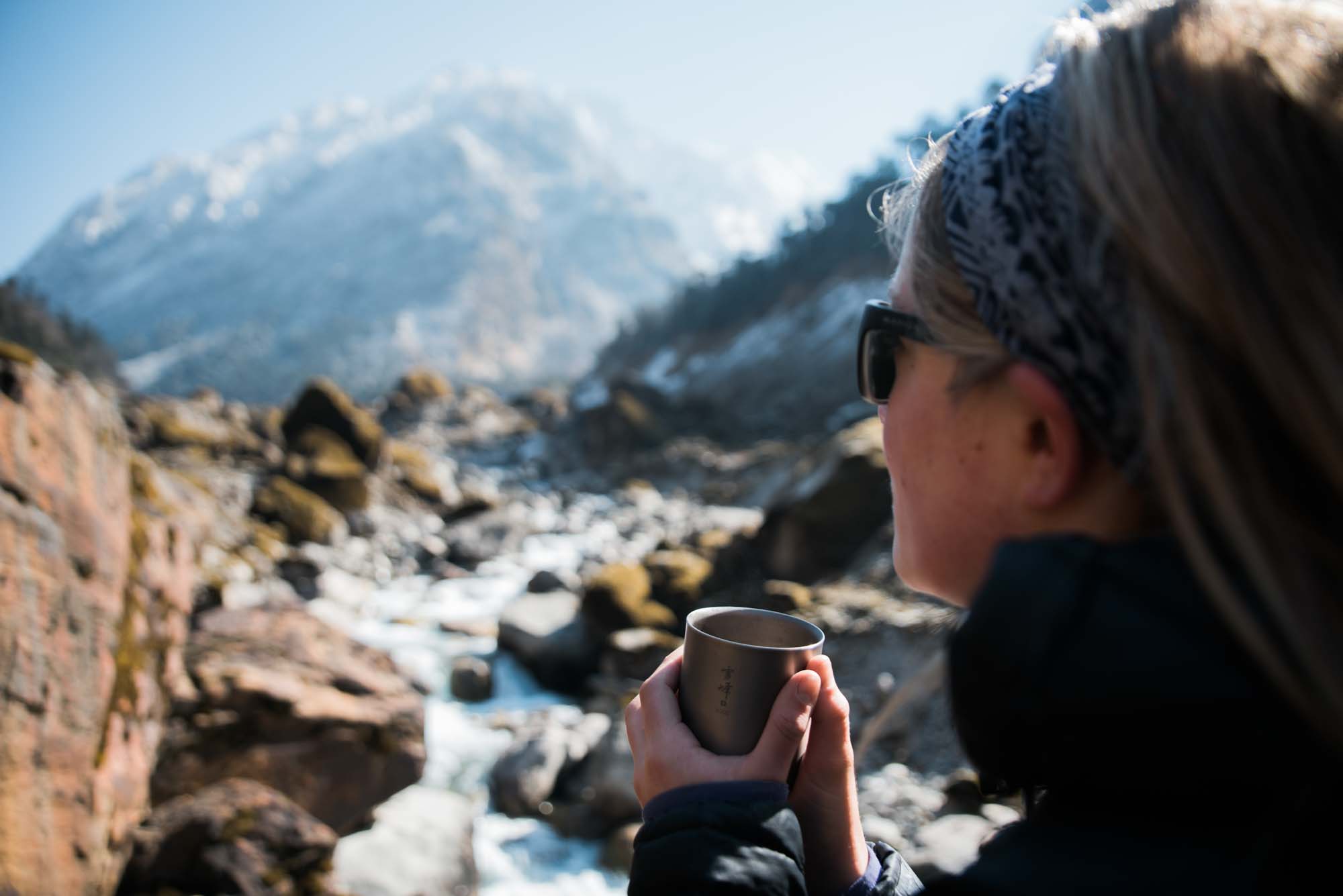Charlotte Austin – There must always be coffee
It’s 1 a.m. on the day of a summit attempt and Charlotte Austin can smell the cold. The thought of leaving her warm sleeping bag and putting on a freezing sports bra is not appealing. The guide and travel writer hauls herself out of her tent with one goal: coffee. Everything else is flexible, but there must always be coffee.
On the mountain
When Charlotte first began leading trips in her early twenties for her current employer International Mountain Guides, she did it because the job paired well with her creative writing master’s program. She would devote herself entirely to guiding trips and then go home and be just as intently focused on her school work. Being with clients on a climb is physical and extroverted while writing is solitary and sedentary. Charlotte noted that if one thing slipped the other would too. She constantly seeks a balance.
“Guiding is difficult. It’s transient, it’s not great money. It’s really hard on your body but it interacts so well with writing. I wouldn’t make it as a guide or a writer without the other,” she noted. Charlotte loves guiding and has worked incredibly hard to be where she is.
Once the group of guides and clients gets moving and her body warms up, Charlotte always remembers why she loves the mountains.
“I look up at the stars and feel the silent camaraderie with my team. It always comes together. I’ve learned that if I show up, the magic comes. But goddamn do those early mornings hurt,” the 29-year-old shared.
As of late 2016, Charlotte has visited and climbed mountains on 6 of the 7 continents and climbed two of the famous 7 summits: Aconcagua and Kilimanjaro. She’s been to Africa, Europe, Australia, North and South America. She would sell a toe to get to Antarctica, but she hopefully won’t have to. IMG leads trips to 16,067-foot Vinson Massif, the highest mountain on the continent.
“Hi, I’m Charlotte Austin. I’ll see you at the airport in (destination city)!” is often the only introduction new clients have before they spend a week or more in near-constant contact in the middle of nowhere.
Charlotte recognizes the travelers from the passport pictures that come as a part of a client dossier weeks before she packs up her gear.
Most of her clients are highly successful and motivated individuals. She says you have to be to spend thousands of dollars and a week or more of vacation time on extensive gear, trip insurance, preparation and the overall excursion. A 12-day Kilimanjaro climb and African safari through IMG costs $6,300 USD. Add that to flights (Chicago to Tanzania is around $1,200 one way) and gear costs (several hundred dollars, depending on where you rent from, or several thousand dollars if you prefer to purchase your own).
IMG recommends that clients prepare for the Kilimanjaro trip by doing stair climbing, bike riding and running hills to build up their endurance. The mountain involves strenuous hiking at high altitudes, so getting ready is about gaining stamina and strengthening the lungs, heart and legs. That means determination and some serious gym time.
Shorter, closer-to-home trips like the Mt. Shuksan Women’s Clinic Charlotte is leading in August 2017 cost far less, around $1,500 USD and require less expensive gear and travel costs. She wants to provide more accessible trips along with the longer, more costly options to reach a wide range of clients.
The temporary mountaineers are often surgeons, lawyers and CEOs who are physically fit and driven to achieve their goals. “One of the things I love about my job is that you get to take these people and put them in a position where they’re uncomfortable,” Charlotte said.
“Shit’s going to come up for them. You speak to them honestly and directly, which most people aren’t used to.”
Some people sign up for treks and climbs because they want a physical challenge or to improve on outdoor skills. Others opt to make the trip with family members and hope for an intense shared experience as they get to know the area’s culture or seek communion with a higher power.
Being a guide means frequently switching between roles as leader, medical aid, risk assessor, friend and life coach. On occasion people refer to her as a group mom, which she quickly shuts down. Clients don’t call male guides the “group dad” and she prefers to avoid the gender bias.
Each and every client has their own things going on back home. For Charlotte, honesty is key. She’d rather have someone who is pessimistic or panicky and willing to talk than a person who won’t speak his or her mind.
“People communicate in many ways at any second. Let’s say you’re evaluating a climber on your rope team and it’s 3 a.m. You’ve been out four hours with 10 more to go and you say, ‘How are you doing?’ It’s a totally different thing if they’re like, gasping and starfished on the snow, not eating and drinking and saying, ‘I’m great. I’m fine. Let’s keep going.'” She explained. “That’s a totally different thing than sitting on your backpack eating a PowerBar saying, ‘Man, this is tough but I have it in me.”
Dr. Albert Mehabrian, a psychologist and researcher of nonverbal communication, found that a message is 7 percent words, 38 percent tone of voice, rate of speech, volume and vocal pitch. The other 55 percent is made up of facial expressions, postures, hand gestures and other body language. Charlotte and other guides must note all of this information to fully understand how their clients are doing, especially if they aren’t communicating openly.
In Charlotte’s experience, women, in particular, can take some time to adjust to this type of communication. She believes that girls are taught from a young age to be indirect, shy or even coy, saying things like, “I don’t know,” or “Maybe…” instead of being absolute and honest. Unlearning these habits can take a lifetime and she is still working on it herself.
A 2009 study published by the American Political Science Association would agree. The researchers noted that women are more likely to say they don’t know the answer unless they are certain. Since many of the female clients Charlotte works with have little to no mountaineering or trekking experience, they may not know what they’re capable of and therefore are more likely to say, “I don’t know” or downplay how they’re feeling.
On a recent trip, Charlotte made the tough decision to call off a climb. This meant direct language. There was no, “Maybe we should…” or, “I think…” The guide told her team she estimated a 1 percent fatality risk if they pushed on and most replied, “Oh! That’s fine!” For Charlotte who spends around 100 days every year in the mountains that would mean dying once every 365 days. In her words, those are unacceptable statistics.

High altitude high metabolism
From mid-June to early August 2016, Charlotte spent 3 weeks on Kilimanjaro, the famous 19,341-foot mountain in Africa. There she led three climbs, losing almost 20 pounds due to her altitude-heightened metabolism. The guides weight fluctuates throughout the year depending on how recently she’s been on a trip.
“Not many females would say, “I’m carrying more muscle right now and that’s fine. I just got back from Everest and I don’t have much body fat anymore.’” She shared.
Being in the mountains has given Charlotte a unique relationship with her body. She routinely changes from 170 to 145 pounds and can drop a pants size while gaining 15 pounds of muscle. When not on a trip she stays in shape by doing high-end cardio, core and upper body strength training. Most of her exercise is to prevent injury and overuse issues through stretching and stability work.
She noted that many guides have joint problems because of intense repetitive use of their bodies. Despite the many risks, Charlotte doesn’t see an end to guiding in the near future.
“As soon as it stops teaching me things I’ll do something else,” she declared, adding that she’s covertly trying to convince her boyfriend Bryan Aulick to sail around the world with her one day. “I never want to stop guiding because I feel like I have to.”
Women of the industry
Charlotte recently led a trip on Rainier with a co-guide who had a 10-month-old baby. The aerospace engineer pumped breast milk on the mountain. Even the men on the trip were impressed.
“I thought, ‘How fucking cool for your daughter.’ The kind of example I’d like to set for kids of either gender is not that mommy was a mountain guide until she got married and had kids. There is nothing wrong with that, but I think it would be really cool and rewarding to set an example like that as long as I could.”
Mountaineering companies are just now starting to make gear in sizes that fit women. The day remains to be seen when the “Pink it and shrink it” philosophy is kicked to the curb for good.
During her first few years as a guide, Charlotte was very careful about her looks. She never wore mascara or anything tight. Now, with a beefier resume and technical skills, she’s not afraid to show up for gear check with her hair down. A part of this attention to detail is not wanting to appear weak.
“I’ve spent most of my 20’s working my fucking ass off to make sure I’m not the last one. You never want to be the last one ready. You don’t want to be the last one trying to grind out a hike. You do everything you can to not be the last one. That runs really deep, you know?”she shared.
Upon her August return from Kilimanjaro, the guide and writer flew straight from Africa to the Summer 2016 Outdoor Retailer Show. Many people at the show remarked that her weight looked great. Charlotte disagreed.
“I wasn’t psyched with my body. I felt weak and fragile and looked like I’d just been sick. I was less strong and capable. The muscle will come back in a few months – that’s normal – but I was mad that people said going from a size 8 to a 4 looked healthy. That’s a dangerous message if you’re not careful.”

Home
Charlotte spends a lot of time in tents, and while she is comfortable in them they don’t feel like home. Her permanent residence is in the Pacific Northwest where she drives or takes the train between her apartment in Seattle, Washington, and Bryan’s in Portland, Oregon. A staple of said home is a Lab/Great Dane mix named Huckleberry. The handsome giant is often shy when she returns from a long trip but warms up after a day or two.
“That used to hurt my feelings,” she admitted. “But I also believe that leaving my family comes with an obligation to be aware of what that experience is like for them, not just for me. It’s easy to come home with stories, scars and souvenirs from other continents, but it’s really important for me to be respectful of what’s happened while I’ve been gone.”
The guide’s parents have mixed feelings about her love affair with mountains but they know she’d do anything to let them know she’s OK in the event “the shit hits the fan.” Charlotte considers it a gift that her family understands why she travels and adventures, and re-integration takes compassion, communication and flexibility.
Bryan keeps in touch via cell phone whenever possible, sending photos of the pup, who lives in Portland while Charlotte is away. Each day, Bryan and Huckleberry stroll through green, misty Forest Park. Huck always grabs a stick and carries it in his huge mouth for the entirety of the walk. Once they leave the park, he drops it in his growing stick pile of souvenirs.
Charlotte, on the other hand, doesn’t feel the need to procure trinkets everywhere she goes, especially after 6-7 years of intensive travel and guiding to around 15 countries a year. If she purchases anything, she wants honest, interesting, quirky and real things. She models Leave No Trace Principles in her personal and professional life, noting that everyone can’t take a rock from Kilimanjaro – what would be left?

Writing and ‘real life’
Charlotte could have easily started a blog about her experience as a woman in the mountaineering industry and called it a day. Thankfully, she didn’t. In fact, the writer has zero desire to start a blog. Instead, she still seeks the balance between mountain time and solitary writing while crafting everything from gear listacles, advice on dealing with altitude and even the cover story for Alpinist Issue 52. You’ll find her work on gear websites like Thermarest and MSR, as well as Misadventures Mag, Stay Wild Magazine and Seattle Magazine. Her life is funded and fueled by this combination of active, physical work and cerebral writing.
When not in the mountains or working on her next piece, Charlotte enjoys climbing and spending time with friends and family. She also savors alone time, a commodity she doesn’t often get while guiding.
Many people are freaked out about the lack of bathrooms at high altitudes. Charlotte, however, has different priorities. “Everybody has their thing on an expedition that has an emotional cost. I’ll poop in a bag – there is no emotional cost for me,” She brazenly admitted. “I could go to the bathroom outside for the rest of my life and not think twice about it. Not being able to have 10 minutes alone is a big thing for me.”
At home she enjoys pedicures, hot baths and haircuts, or as she calls them, “girly things.” She considers it a good way to balance out hard labor with femininity. She also loves fresh fruit and vegetables and can craft a mean cobbler whether in the back or front country. You can often find her spending time “dealing with her inbox” or as she calls it, “bailing out a rowboat with a teaspoon.” Here here, sister.
Charlotte’s Instagram is full of gorgeous places that she travels to for fun (like caribou hunting in Alaska) and for work (mountains and more mountains). But she’s not just capturing pretty places. Each post features an interesting tidbit about her experience, the culture of the area or a location tag. She shares small meaningful stories, tiny windows into her day-to-day adventures. We keep hoping to spot a photo of whatever makeshift pillow she’s using this time – it’s sometimes a coil of rope covered in a fleece. Charlotte claimed she’d rather use a cold boot than go without a pillow.
You can follow Charlottes adventures, writing and learn about upcoming trips here:
On the Web – www.charlotteaustin.com
Instagram – @charlotteaustin
Facebook – Charlotte Austin
And check out Bryan’s photos at:
On the Web: www.bryanaulick.com
Instagram: @bryanaulick


Great article!